Journal of
eISSN: 2373-6453


Review Article Volume 2 Issue 5
Italian Air Force, Logistic Command, Health Service, Italy
Correspondence: Roberto Biselli, Italian Air Force, Logistic Command, Health Service, Aeronautica Militare, Comando Logistico, Servizio Sanitario, Via P, Gobetti 2/A, 00184 Rome, Tel 390649865383
Received: August 14, 2015 | Published: August 28, 2015
Citation: Biselli R (2015) Aeromedical Evacuation of Patients with Hemorrhagic Fevers: The Experience of Italian Air Force Aeromedical Isolation Team. J Hum Virol Retrovirol 2(5): 00058. DOI: 10.15406/jhvrv.2015.02.00058
The recent Ebola Virus Disease (EVD) epidemic in West Africa has emphasized the problem of a safe Aeromedical Evacuation (AE) of patients with highly contagious infectious diseases (HIDs), in order to perform a treatment in Biosafety Level 4 hospital units. Since AE of infected patients may cause unique challenges and risks to air crews and medical personnel, it is appropriate to engage a dedicated flight with the deployment of Aeromedical Isolation Team (AIT). AIT is a rapid response team which can be deployed anywhere in the world, to transport patients with highly contagious infections and provide them medical care under high-level containment during the flight by the isolators. Maximum biological containment is achieved during air transportation by a specific stretcher system called “Air Transport Isolators” (ATI) that completely isolates the patient from the surrounding environment. A kind of activity as AE of HIDs requires a training at the highest level and all procedures must be fixed and try over and over again.
In recent years, besides the use of biocontainment systems so-called “closed”, such as the ATI, another concept of containment is being proposed, the “open isolation approach”, which provides patient and medical staff placed inside a mobile isolation unit (e.g., tent, container, ambulance). The two recent AEs of patients infected with EVD carried out by Italian Air Force AIT demonstrate that:
Keywords:Open Isolation Approach, Containment, Diseases
EVD, Ebola Virus Disease; AE, Aeromedical Evacuation; HIDs, Highly Contagious Infectious Diseases; AIT, Aeromedical Isolation Team; ATI, Air Transport Isolators; MERS, Middle East Respiratory Syndrome; AFB, Air Force Base; NGO, Non Governmental Organization; USAMRIID, USA Army Medical Research Institute of Infectious Diseases; MERS, Middle East Respiratory Syndrome; BSL4, Bio-Safety Level 4; INMI, National Institute for Infectious Diseases; SARS, Severe Acute Respiratory Syndrome
Although the great advances in medicine, serious communicable diseases are yet a significant threat. Every year worldwide epidemic emergencies come out due to new emerging or reemerging highly infectious diseases, such as avian flu virus (H5N1) in 2002, Severe Acute Respiratory Syndrome (SARS) in 2003, Marburg Hemorrhagic Fever in 2005, Ebola Virus Disease in 2014 or Middle East Respiratory Syndrome (MERS) in 2015. In the past centuries the spread of infectious diseases basically occurred by shipping business and by the displacement of soldiers during the continuous military conflicts. Nowadays the situation is completely changed, and by air it is possible in few hours to fly across the world: the growing mobility of people for tourism and business travel, the increase of military contingency operations, especially in tropical environments, and the potential use of biological weapons by bioterrorist have amplified the risk to contract a highly contagious infectious disease.1
Aeromedical Evacuation (AE), defined as long-distance transportation of patients (>300 km) following initial treatment allowing a successful relocation,2 supposes a careful evaluation of the clinical conditions of the patient relatively to the risks of an evacuation’s inherent hazards and in order to avoid any deterioration of the illness. In fact, the effects of altitude must be considered and the physiological responses to hypoxia, barometric pressure change with gas expansion in body cavities and decompression sickness, vibrations, turbulence, temperature changes, dryness, noise, etc. can be immediate and life threatening. For these reasons medical contraindications to AE have to be assessed relative to the risks for the patient of forgoing advanced treatment.3,4
However, AE of infected patients may cause unique challenges and risks to air crews and medical personnel since the airplane is a suitable environment for the spread of pathogens carried by passengers,5-7 for which infectious diseases represent one of the few absolute contraindications to AE.4,8 The recent EVD epidemic in West Africa has emphasized the problem of a safe patient evacuation to perform a treatment in Bio-Safety Level 4 (BSL4) hospital units.
Decision to evacuate
In general, it is recommended that cases of suspected infectious diseases should not be transported by air and the first choice should be treat the patient in place, but if we have to transport the patient, we must evaluate each case individually, decide what kind of flight and which containment measures of biocontainment should be used.9,10 All decisions, especially the most difficult, taken in critical conditions such as those that threaten public health, require a clear assessment of the circumstances.
If the operational decision is for the AE of the patient, a choice has to be taken between a dedicated flight and the deployment of Aeromedical Isolation Team (AIT) with the isolators. With dedicated flight we have a flight with the features reported in (Table 1), but if the management of infected patient poses particular risks to air crews and medical staff, in particular if the subject is symptomatic and we know that has been exposed to viral hemorrhagic fever, or if there is the suspect of biological attack, it could be more indicated to turn to a dedicated flight with the deployment of AIT.8 In (Table 2) are reported the infections and conditions requiring biocontainment care during transport, as stated by Christopher et al.7 and according to the WHO information.9
Flight with dedicated Aeromedical crew |
Use by medical staff of Personal Protective Equipment (PPE) |
Patient must be in an isolated area of the aircraft |
Bathroom dedicated to the patient |
Patient must wear appropriate protective mask |
Disinfection and decontamination procedures of the aircraftat the end of the mission |
Table 1 Requirements on board an aircraft dedicated to the transport of a subject suffering from potentially highly contagious infectious disease
Arena virus infection (Junín, Matchup, Sabia, Guanarito viruses, Lassa fever) |
Bunya virus infection Congo-Crimean hemorrhagic fever) |
Filovirus infection (Ebola, Marburg) |
Orthopoxvirus (Monkeypox, Variola) |
Pneumonic plague |
Potentially lethal communicable diseases for which no effective treatment is known |
Any unknown, virulent, communicable disease pending diagnosis |
Table 2 Infectious diseases requiring biocontainment care during air and ground transport
The Aeromedical Isolation team of Italian Air Force (ItAF)
AIT is a rapid response team which can be deployed anywhere in the world, to transport patients with highly contagious infections and provide them medical care under high-level containment during the flight. For long-distance international and domestic AEs of these patients, since 2005 ItAF provides a rapid-response team located on Pratica di Mare Air Force Base (AFB), with the aim to relocate suspected or confirmed cases with HDIs in specialized hospitals and provide medical care under high-level containment. In Italy, two referral centers for HDIs in Rome (National Institute for Infectious Diseases – INMI – “L. Spallanzani”) and in Milan (Hospital “L. Sacco”) currently provide care for HDIs patients if transport is feasible.11
The AIT of ItAF consists of two teams ready to act, each comprised at least of three physicians (the team leader, a flight surgeon who is responsible for medical consultation and control of the team, and two specialists, respectively in infectious diseases and anesthesiology) and six nurses. When necessary, considering the features of the mission, the number of physicians employed may be increased. A key concept is that the AIT is not designed for mass casualty evacuation but is directed only to a limited number of cases.
Maximum biological containment is achieved during air transportation by a specific stretcher system called “Air Transport Isolators” (ATI) that completely isolates the patient from the surrounding environment protecting health care personnel, air crew and the aircraft from exposure to infectious agents (Figure 1a), and simultaneously provide the needed accesses to perform treatment procedures, including resuscitation maneuvers (Figure 1b). ATI system maintains a microbiological barrier by means of some levels of protection as:
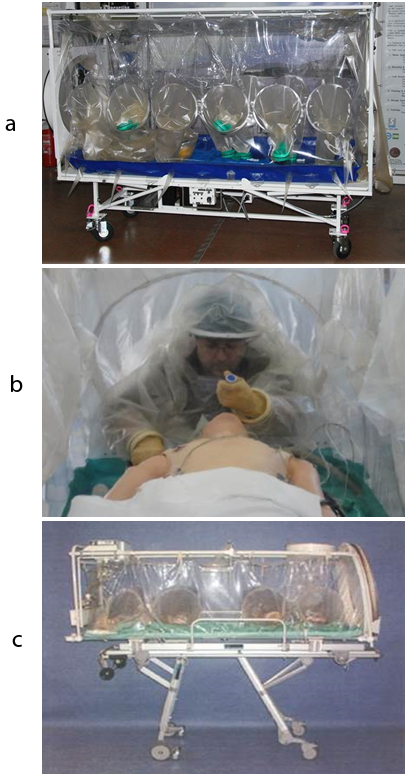
Figure 1
The ATI used by ItAF is a system developed in U.K. in the 1970s and manufactured until 2007 (12), while the model currently in use, “A.T.Isol.” stretcher, is a version modified by an Italian factory (OMP Engineering Srl, Dueville, VI, Italy). In addition to ATI, for short-distance transport (<3 hours) ItAF utilizes two specifically designed smaller stretchers:
a. “Stretcher Transport Isolator” (STI), a stretcher similar as characteristics but smaller than ATI, used for ground ambulance transportation and for passage from aircraft to ground vehicles (Figure 1c) the “N36” model (Beth-El Zikhron Yaagov Industries Ltd, Israel), even smaller in size in comparison to STI, for transportation by helicopter or by ambulance (Figure 2a). In addition to these devices, ItAF AIT is equipped also with an isolation tent for stand-by care, in order to ensure a continuity of care in case of prolongation of the mission due to technical problems or if the patient needs to be managed before transport can be accomplished (Figure 2b). ATI and STI systems feature transparent PVC envelopes including gloved sleeves, transparent half suite, transfer and docking ports for patient entry, transfer and supply ports for introducing supplies and various sealed cones to pass tubes and wires (Figure 3).

Figure 2
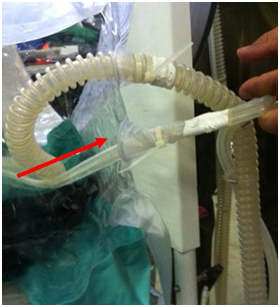
Figure 3 ATI and STI systems presents various sealed cones (red arrow) to pass tubes and wires used for the connection with devices external to the stretcher that allow the operators to monitor the clinical conditions of the patient and make treatment interventions.
The ItAF AE capabilities are achieved for short-distance range with helicopter or with Alenia C-27 propeller aircraft, for medium-distance range with Lockheed C-130 J, and for long-distance range with KC-767 platform, which is a military version of Boeing 767. When using a new system or device on board of an aircraft, it is necessary a flight certification process to evaluate the airworthiness of the system. In this case the certification involved several issues such as ATI boarding (high loader on KC-767), restraint device, power supply, electromagnetic interference, vibration, weight, ATI fastening on pallets, dedicated gap fillers for pallets, emergency egress procedures. All equipments and systems utilized by ItAF for AE of infected patients are certified by ItAF Flight Test Center, which is the Airworthiness Authority for the attainment of the Military Certification.
Aeromedical evacuation process
Three phases have to be considered for AE process: a) patient reception and isolation; b) in-flight patient care (monitoring and treatment); c) patient transferring (ATI↔STI).
Patient reception and isolation: The first step is the clinical evaluation of the patient, since only subjects likely to survive transport would be evacuated. The ppatient is directly isolated inside the ATI, if he has been carried to a transfer point near the aircraft, or inside the STI if the team members have to take and start to manage the subject to a distant location from airport. During this operation the team must wear PPE according to the level of risk; after introduction of the patient in the stretcher the isolator is closed and decontaminated in the point of entry, such as also staff personnel is decontaminated and PPE removed (Figure 4).
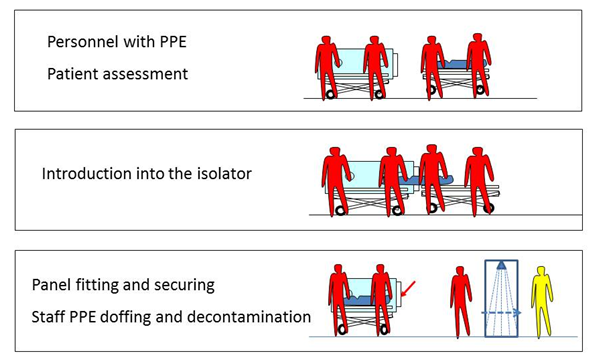
Figure 4 Procedures for patient reception and isolation within the ATI (or STI, depending on the requirement). In this step the team members must wear PPE according to the level of risk:
In-flight patient care (monitoring and treatment): During the flight, patient management represents a crux of the AE of infected cases. With ATI, that is a closed isolation system, medical staff, although is outside the isolator without further protective equipment, can have access to the patient for medical care up to Intensive Care Unit (ICU) level, working by transparent half suite and gloved sleeves. In addition, various sealed cones allow switching tubes and wires connected to a “Patient Care Module”, placed just off the isolator (Figure 5). This care module includes several devices that allow us to monitor the clinical conditions of the patient and make treatment interventions throughout the flight (by defibrillator, ventilator, suction unit, infusion pumps). It is important to underline that anything we may want to use in emergency must be inside the isolator before placing the patient in it.
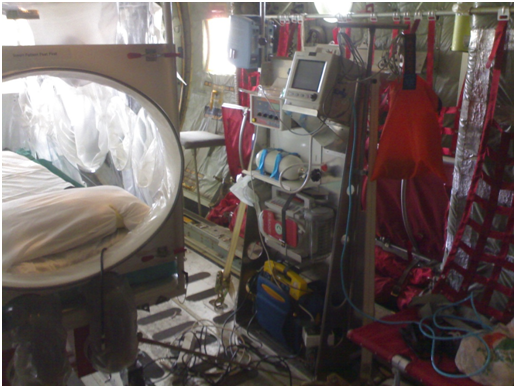
Figure 5 During the flight the patient is managed by the anesthetist who can have access to the patient for medical care up to Intensive Care Unit (ICU) level, working by transparent half suite and gloved sleeves. In addition, a “Patient Care Module”, placed just off the ATI, allows him to monitor the clinical conditions of the patient and make treatment interventions throughout the flight (by defibrillator, ventilator, suction unit, infusion pumps, etc linked by wires to the patient).
Patient transferring (ATI↔STI): After the flight, at the final destination airport, the patient is moved from ATI to STI by a connection with a transfer sleeve, without breaking the microbiological barrier, for the transport by ambulance to the hospital. Personnel can work without PPE, because in this phase the operation is safe, the system is closed and clean (only few AIT members wear PPE for the management of a possible emergency). In (Figure 6) are represented the subsequent phases of the ATI↔STI transfer.

Figure 6 Procedures for patient transferring (from ATI to STI or vice versa, depending on the requirement). At this stage it not necessary that AIT members wear PPE, since the system is closed and clean:
Deployment of Aeromedical isolation team
The first operational deployment of the AIT occurred during the January 2006. Since then the team has been put into service several times, for the transport of patients with suspected HIDs such as cases of Congo-Crimean fever (2007) and Monkeypox virus (2014), up to the recent transports of two cases of confirmed cases of Ebola Virus Disease.13,14 The first case refers to an Italian physician, a 50-year old male from Emergency team, a Non Governmental Organization (NGO), who developed the infection in Africa. The transport was carried out on November 24, 2014, from Freetown, Sierra Leone, with an ItAF KC-767. The clinical conditions of the patients were stable so that no special maneuvers of assistance were necessary during the transport (Figure 7). Under 30 hours from the point of activation, the patient arrived at Pratica di Mare AFB. On the ground, the patient was moved from ATI to the STI, following procedures established, and transported to L. Spallanzani INMI. In this phase both military and civilian teams were involved and worked together. After 21 day of health surveillance of aircrew and AE Team, ItAF declared the success of the mission since the virus had been contained. After his stay in Spallanzani hospital for 5 weeks, during which he received different experimental treatments, the patient recovered fully.
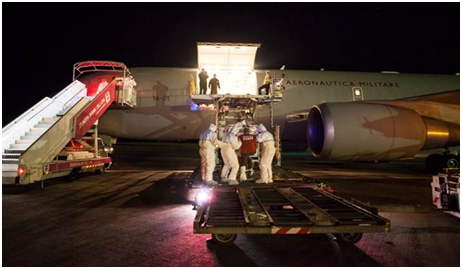
Figure 7 At Free Town Airport (Sierra Leone), the patient (a physician, aged 50, EVD positive, clinically stable) is directly loaded into the ATI before the flight to Italy with a KC-767 of Italian Air Force.
The transport of a second case of EVD occurred on May 12, 2015, and refers to an Italian nurse coming back in Italy from Sierra Leone, where he worked for some months as volunteer for NGO Emergency. The first symptoms appeared three days after his return to Italy, at his home in Sassari, Sardinia Island. Also in this case ItAF AIT transferred the patient in few hours by the call from Sassari to Pratica di Mare AFB, and here the usual procedures were carried out with the team of L. Spallanzani INMI for the admission to Spallanzani Hospital. Also in this case the virus had been successfully contained and the patient completely restored to health. About the possible difficulties arising from the space-conserving design of ATI which counteracts the provision of care equivalent to that in an intensive care unit, the lesson learned from a bio-AE of ItAF AIT carried out in 2007 is very significant. This case refers to an Italian man just returned to Italy, coming from Asia with a suspected Congo-Crimean fever. The transport occurred from Turin, North Italy, to Spallanzani hospital in Rome. The clinical conditions of the patient were very impaired and he had the need to be incubated and ventilated throughout the flight, for about 1 hour and half of flight, without any difficulty by the anesthetist. The patient died in hospital after 2 days, with a final diagnosis of severe disseminated Herpes Virus infection.
In this kind of cases, it is appropriate reiterate the concept that all lifesaving interventions and monitoring procedures, as intubation and placement of intravenous lines and Foley catheters, that are likely to be needed during the AE, should be performed before flight, preferably in the departure hospital. Therefore, a meticulous packaging of patient before the flight will increase the possibility to avoid the risk of injuries associated with handling and turbulence.
Training and collaboration between military and civilian Italian institutions
A kind of activity as AE of HIDs requires a training at the highest level and all procedures must be fixed and try over and over again. The training is focused on several aspects, especially on use of PPE, recovery of contaminated patient, patient management in the stretcher (both in flight and ground) and equipment’s decontamination. ItAF carries out its training activities not only within his own AIT but also in close relationship with homologous units of civilian organization such as the two Italian referral centers for HDIs in Rome (INMI, “L. Spallanzani”) and Milan (Hospital “L. Sacco”). In this respect, the collaboration between ItAF and Spallanzani Institute is formalized since 2009 through a “Memorandum of Understanding for Scientific and Technical Cooperation”.15
This activity of training is very useful not only in order to exchange opinions and knowledge on the devices and procedures, but also because makes possible a joint action between the different components of “Italy system country”, according to “Viral Hemorrhagic Fevers, guidelines for the transport” of Italian Ministry of Health11 and to an “Inteministerial agreement” among Health, Defense, Foreign Affairs and Interior Ministries. In addition, there is also collaboration with the Armed Forces of other countries engaged in this activity, in particular with the AIT of USA army. In fact, in the stage of forming the AIT, the first members of ItAF AIT have been trained at the USA army Medical Research Institute of Infectious Diseases (USAMRIID), in Fort Derrick base, Maryland. In the following years the collaboration between the two AITs continued with a joint-training.
New approaches for transportation of HDIs in BSL-4: “Closed” vs “Open” isolation approach
The risk of transmission of infection for medical staff and flight crew during AE of HID patients can be minimized by isolating the patient during transportation. In recent years, besides the use of biocontainment systems so-called “closed”, such as the ATI and the STI devices, another concept of containment is being proposed, the “Open isolation approach”. Therefore, there are two possible isolation approaches:
Basically, with the “closed system” the patient is placed inside a physical containment (an isolation stretcher) with negative pressure inside and exhaust air purified by an HEPA filter. Integrated gloves with long gauntlets allow basic patient handling from outside. Medical staff and the flight crew are outside the isolator and not need further protection in the cockpit. The advantages are: excellent level of protection for the personnel;
Easy to implement. Conversely, the drawback consists in the fact that any enhanced monitoring or treatment interventions for patients with unstable or deteriorating conditions may be difficult. With the “open isolation system” the patient and the medical staff are placed inside a mobile isolation unit (e.g., tent, container, ambulance), provided with all the medical equipment necessary for enhanced monitoring and treatment interventions. Medical staff must be protected by PPE; most types have negative pressure with air purified by HEPA filter. The advantages are: full access to the patient throughout the flight enables medical care up to ICU level. The drawback is represented by: highly complex logistics, labor-intensive and very cost-intensive. In (Table 3) the main features of the two approaches are compared.10,16
Closed Isolation approach |
Open Isolation approach |
Patient placed inside a physical containment: an isolation stretcher with negative pressure |
Patient and medical staff are placed inside a mobile isolation unit (e.g. tent, container, ambulance) |
Medical staff outside without PPE |
Medical staff protected by PPE |
Integrated gloves allow patient care, enhanced treatment for unstable patient may be difficult |
Medical care up to ICU level throughout the flight |
Easy to implement |
Highly complex logistics |
Table 3 Comparison of the features of two different operational approaches to transportation of infected patients: “Closed isolation” versus “Open isolation” system
Regarding the kind of system, ItAF decided to use a “closed isolation approach” since 2005, from the start of this activity, and still remains convinced of the goodness of this choice, for several reasons: at the beginning because ATI and STI isolators were already in use by other countries with specific experience at that time (US Army and UK-Royal Air Force); the system is flexible and easy to implement; it is suitable for different aircraft (C-27J, C-130J, KC-767), for both tactical and strategic operations; it is a modular structure that can be used by supplementing it with an isolation tent to ensure the continuity of patient care; finally, our direct experience of ten years on the field has showed that the system allows many monitoring and treatment interventions (i.e. intubation, ventilation, infusion of fluids).
The recent outbreak of EVD in West Africa has highlighted some questions related to the AE of patients with HIDs. The lessons learned from a ten year experience of ItAF AIT and, in particular, from the last two transports of patients infected with hemorrhagic fevers, can be summarized:
These considerations underline that only an accurate preparation work, based on the arrangement of reliable, harmonized and tested procedures, is able to provide the highest level of effectiveness.
None.
None.

©2015 Biselli. This is an open access article distributed under the terms of the, which permits unrestricted use, distribution, and build upon your work non-commercially.